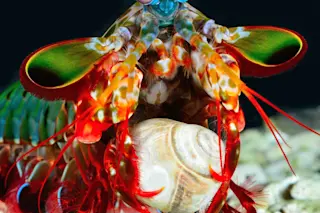Prepare to be smashed. (Credit: Roy L. Caldwell, Department of Integrative Biology, UC Berkeley)
A version of this article originally appeared on The Conversation
. When you think about fearsome predators in the ocean, the first thing that pops into your mind is probably a shark. Sure, sharks are OK, with their sleek, menacing shape and their gaping jaws with rows of jagged teeth. But if you were a fish living on a coral reef or cruising along the shore over the sands of a tropical island, you would fear a far more terrifying predator. Consider an armored, tank-like creature looking something like a lobster. Most are quite small, often tinier than your little finger, though some can be as long as your forearm. This animal doesn’t swim around like a shark; instead, it hides in the sand or in rocky holes in coral, searching the water above with constantly ...














